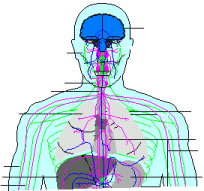|
Clinical Indications and Goals for IPPB |
Patients afflicted with diseases that limit the depth of breathing can be have their VT increased, sometimes as much as fourfold, with IPPB. The single overall clinical goal of IPPB therapy is to provide patients with a significantly larger VT at a physiologically advantageous inspiratory-to-expiratory pattern than the they can produce with spontaneous ventilation.
In the past, IPPB therapy was administered for a host of reasons, some well founded and others without any sound clinical or physiologic basis. Today, this shotgun approach to using IPPB is no longer acceptable. As discussed earlier, the use of IPPB must be supported by corroborating patient data that clearly indicates a potential benefit. Substantiated indications for IPPB include:
- To improve lung expansion: It is important that patients be
able to breathe deeply so they can maintain an effective cough mechanism
to facilitate removal of secretions from the airways. An effective cough
maneuver involves taking a deep inspiration, the glottis closing, the
diaphragm and other muscles of respiration contracting, and achievement
of high interpulmonic pressure. The pressure is then strongly released
causing the gas behind the secretions to move upward at high velocities
carrying out the secretions. Patients unable to make these deep inspirations
may need IPPB therapy may assist their efforts.
IPPB can also be helpful for patients with atelectasis that has been unresponsive to other therapies. A correctly administered IPPB treatment can provide these patients with augmented tidal volumes, achieved with minimal effort.
The optimal breathing pattern to reinflate collapsed lung units with IPPB consists of slow, deep breaths that are sustained or held at end-inspiration. This type of inspiratory maneuver increases the distribution of inspired gas to areas of the lung with low compliance, specifically, the atelectatic areas. While IPPB proven successful in treating atelectasis, there is little evidence of its prophylactic value in preventing the occurrence of this postoperative complication.
|
 |
- To aid in the delivery of aerosolized drugs: Administering
medications via aerosol helps assure that they will be deposited deeper
and more equally than other modes of delivery. IPPB helps provide a
larger volume of inspired gas under higher pressures, dilates the airways
and alveoli, bypassing obstructions, and provide an opportunity for
more of the medication to be absorbed. This is particularly helpful
in caring for patients unable to breathe deeply or who may not benefit
from normal aerosol treatment. If IPPB is to be used to deliver aerosolized
medications,the following should be observed:
- Unless tracheal suction is also administered, mucolytics should
not be delivered to the patients without ineffective cough unless
tracheal suctioning is also ordered.
- When an aerosol is delivered via a tracheostomy, the patient receives
a higher concentration of the drug compared to administering the
via a mask or mouth piece.
Therapy that is expensive should be judged on its cost-effectiveness as well as clinical effectiveness. Whether administered to improve the cough, improve distribution of ventilation, or deliver medication, IPPB is justified only if the patient's ability to inspire adequately is limited. The clinical situations indicating a need for IPPB therapy include the following:
- Clinical diagnosis of atelectasis
- Reduced lung volumes, eg:
Vital capacity <10-15 mL/kg
Inspiratory capacity <40% predicted
- Reduced expiratory flows (precluding effective cough), eg:
FEV1 <65% predicted
FVC <70% predicted
- Neuromuscular disorders or kyphoscoliosis with associated decreases
in lung volumes and capacities
- Fatigue or muscle weakness with impending respiratory failure
- Presence of acute severe bronchospasm or exacerbated COPD that fails to respond to other therapy
- Unless tracheal suction is also administered, mucolytics should
not be delivered to the patients without ineffective cough unless
tracheal suctioning is also ordered.